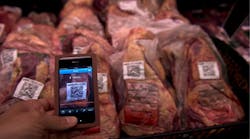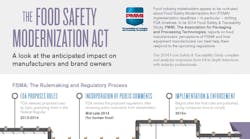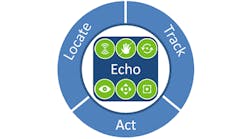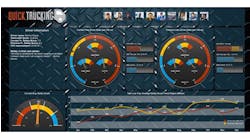For today's ever-demanding consumer, delivering healthy, fresh food requires visibility to its journey from farm to fork. As supply chains become more global and more complex, scrutiny from consumers, government and non-government entities is increasing. Food and beverage companies are not only expected to deliver more, high-quality products, faster and for less, but to provide all the information associated with the origins of ingredients and product materials, as well as the conditions under which they were produced and transported along the value chain.
Historically, these tasks required food safety regulation compliance and loss mitigation strategies, but today decision-makers are focusing on using traceability strategies to enhance efficiencies across the supply chain. Far too often, traceability has had a negative connotation which took the focus away from the benefits it can bring to the overall operation and to the opportunities inherent in the steps taken to meet food safety requirements.
Acknowledge food safety requirements
The first step in a holistic approach to traceability is ensuring that all entities understand the existing regulations, comply with them, and have processes in place to respond to new rules. For instance, the most notable legislation is the FDA’s Food Safety Modernization Act, which continues to provide improved outcomes for both consumers and the food service industry.
For consumers, this Act aims to ensure the U.S. food supply is safe by shifting focus from responding to contamination to preventing it. It requires the food industry to trace food downstream from suppliers, which enables faster recalls from the marketplace. Suppliers can then enact containment processes before contaminated food reaches the consumer. Even if a contaminated product enters the market, traceability can reduce the size of an outbreak by removing it more quickly.
“A brand operating within the category of the recalled product can differentiate itself from the tainted brand to maintain sales and protect its overall image.
On the industry side, using the recall example, a brand operating within the category of the recalled product can differentiate itself from the tainted brand to maintain sales and protect its overall image. For example, if eggs from Brand A need to be pulled from supermarket refrigerators, brands B, C and D may not have to be pulled.
Traceability can enable distributors to track the manufacturing entities upstream and monitor which products were sold, are still in stores, or remain undelivered. This can help maintain sales in the short term, and it can also contribute to the long-term reputation of the brand.
Additionally, if a supplier in a contaminated product’s chain of distribution is implicated, the legal battle can be much less threatening when the true ”at fault” party can be determined. Traceability helps identify material ownership changes and hand-offs through the supply chain to find the true cause of the problem.
All that said, food service companies still have the responsibility to ensure that all parties understand the requirements of food safety, and that participation in a global traceability system is not a substitute for due diligence or legal compliance.
Integrate for a clear supply chain view
Establishing a clear view of all suppliers’ operations is an important step to ensure they have instituted their own traceability programs. It also enables the entire supply chain to adapt to today’s changing business, environmental and government landscapes.
The challenge, however, is that most manufacturing environments contain hundreds, and even thousands of interactions between systems and users. It is rare that all processes are documented, especially when the supply chain is comprised of many parties (i.e. ingredient suppliers , logistics partners, shippers, etc.).
“Traceability can enable distributors to track the manufacturing entities upstream and monitor which products were sold, are still in stores, or remain undelivered. This can help maintain sales in the short term, and it can also contribute to the long-term reputation of the brand.
For example, a supplier operating in Mexico that manufactures and ships raw materials to a Canadian food supplier must use systems that integrate the same data with all partners, not just those working with the local operation. Systems must be able to address complexities with language barriers, varying regulations, safety requirements and logistics.
Depending on the complexity of the supply chain, the use of unique datasets — including an order date or time or a serialized sequence number, generally through the use of a barcode or radio-frequency identification (RFID) — can trace and report the status of a product through the entire production flow. Personnel will scan the product or raw materials at key points along the supply chain, and any number of factors can be determined. This not only links all sections of the operation, it enables system audits as needed, at any point.
Systems can be set up to monitor data as specific as the temperature in a shipping container for food or beverages that require refrigeration, all the way to inspections at customs, trade compliance and international laws. These elements should never impact shipping timetables, but often do. Should a problem occur, decision makers can use traceability to access the recent or real-time data on orders, supply chain activity, transactions, and markets to make decisions instantly.
If certain suppliers are operating at an earlier development stage of supply chain maturity than others or lack technology resources, it may be beneficial to support their system by providing tools, hardware and software to increase and maintain traceability. It is also important to consider alternative sourcing. Qualified suppliers with certain capabilities and lower associated costs may be more worthwhile partners.
International standards, such GS1, have helped organize the syntax and semantics for supply chain events and have secured methods for selectively sharing supply chain data with trading partners. There are now a wide range of products that are certified as being compatible with these standards.
Traceability uncovers new opportunities
Today’s food and beverage companies should take advantage of the supply chain enhancements needed to meet food safety requirements, not only to comply with evolving regulations, but to improve supply network efficiency and overall profitability.
With real-time, dynamic models, supply chain managers and users can input current data and generate outputs to help manage costs, demand projections, and crisis scenarios, reflecting present information with consistent and replicable results. For example, if demand for sweet tea is trending higher in the southeastern region of the U.S., beverage companies can shape supply of ingredients or consumer-ready products more quickly around the demand in the select areas. Examples of other cost-saving or efficiency metrics can include analysis of traffic or weather patterns that identify optimal times and days to schedule deliveries.
With a single, consistent view of clean, reliable data, users spend less time preparing and validating numbers, and more time assessing the impact of unexpected change. The key to a successful integration of a supply chain isn't big data; it is the integrity and usability of all data.
Scott Saunders is senior vice president, supply chain integration, analytics & supply chain services, and Tommy Daigle is supply chain integration project manager, analytics & supply chain services, for HAVI Global Solutions.





